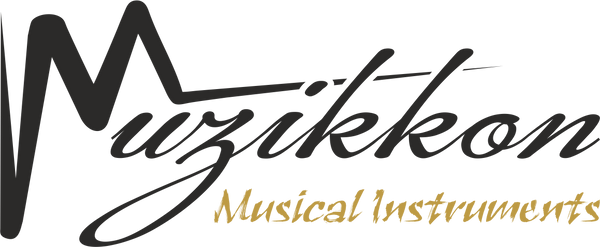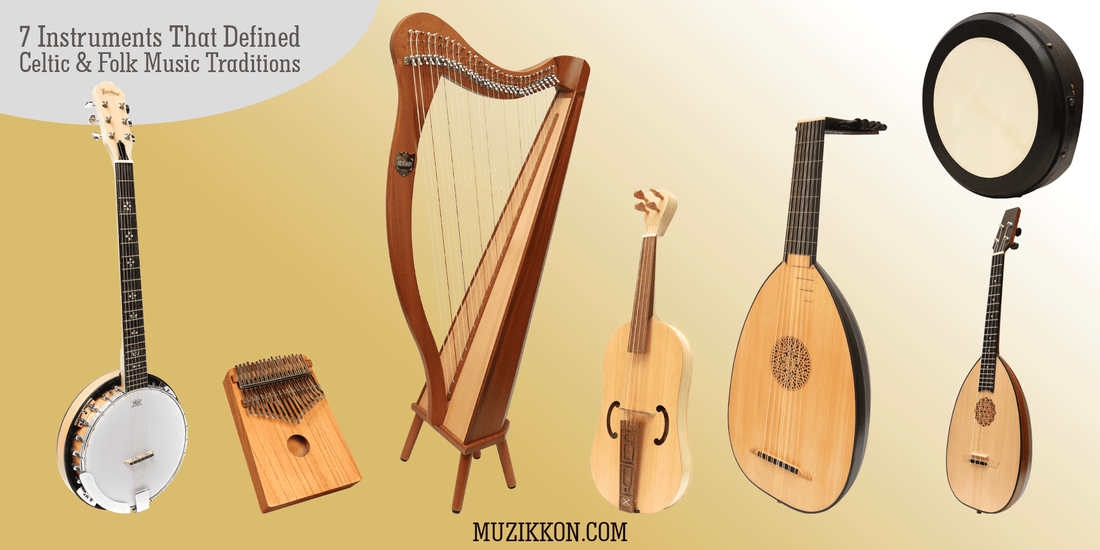Celtic and folk music carry centuries of history, shaped by the communities that created them and the instruments that gave them voice. From village gatherings in Ireland to storytelling across Europe, certain instruments became inseparable from these traditions. They were not only tools of music but also symbols of identity and heritage.
At Muzikkon, many of these iconic instruments are available today, from harps and Lutes to Bodhráns and Banjos, allowing modern players to connect with the same sounds that have resonated for generations. Below are seven instruments that defined Celtic and folk music traditions and continue to inspire musicians around the world.
1. Harps
The Harps is one of the most enduring symbols of Celtic music. For centuries, harpers were respected as carriers of culture, playing at courts, festivals, and village gatherings. The sound of a harp is instantly associated with Ireland, but its influence stretches far across Europe.
At Muzikkon, you’ll find a wide range of harps, from lyre harps that connect to ancient storytelling, to Kinnor Harps with biblical roots, and full-sized harps that continue the Celtic tradition. Their gentle resonance makes them perfect for folk melodies, laments, and ceremonial music.

🔗 Shop Harps
2. Bodhráns
No instrument represents Irish folk rhythm more than the Bodhráns. This frame drum, struck with a wooden tipper or played by hand, provides the heartbeat for Celtic dances and sessions. Its deep, earthy sound supports fiddles, pipes, and flutes, driving reels and jigs forward with energy.
The Bodhrán’s role in folk music highlights the communal side of percussion: it is less about solo performance and more about creating a rhythm that others can join. You can explore handcrafted bodhráns at Muzikkon, designed to stay true to this centuries-old tradition.

3. Lutes
The lute family, including the Renaissance Lute, was central to European folk and early music. These plucked string instruments carried both solo melodies and accompaniment for singers. Their soft but intricate tones made them ideal for storytelling, which was at the heart of folk culture.
Muzikkon’s collection of Renaissance lutes recreates the authentic sound of these instruments. Playing a lute today is like stepping back into the courts and gatherings of the Middle Ages, where folk traditions and formal music often overlapped.

4. Banjos
Although the Banjos is most often associated with American folk and bluegrass, its roots trace back to instruments brought from Africa. In Celtic-influenced music of the 19th century, the banjo became a lively addition, blending with fiddles and guitars in folk sessions. Its bright, rhythmic strumming style made it a favorite for both dance tunes and traveling performers.
Muzikkon offers a variety of Banjos, giving players access to this energetic sound that bridges continents and traditions.

5. Ukuleles
The Ukulele , while originally Hawaiian, became a popular folk instrument across the globe due to its portability and cheerful tone. In Celtic folk revival scenes, it was often introduced alongside guitars and mandolins, adding brightness to group performances.
Its role in folk music today is about accessibility: anyone can pick up a ukulele and start strumming. Muzikkon’s range of ukuleles makes it easy for both beginners and seasoned folk musicians to enjoy its playful sound.

6. Kalimbas
The Kalimbas, also called a thumb piano, comes from African folk traditions but has found a unique place in global folk music. Its gentle plucked notes create a calming, meditative sound, making it a versatile companion for modern Celtic-inspired compositions.
Though not originally Celtic, its role in contemporary folk is undeniable. Muzikkon’s kalimbas bring this accessible and melodic percussion instrument to new audiences who want to blend global folk sounds.

🔗 Shop Kalimbas
7. Medieval and Folk Fiddles
No list of folk instruments would be complete without mentioning fiddles. From medieval rebecs to the violins used in Irish céilí music, bowed strings have always been the storytellers of folk culture. They carry fast-paced dance tunes, soulful ballads, and everything in between.
At Muzikkon, instruments like the Medieval Fiddle connect players to early European traditions. Their expressive voices capture both the joy of community dances and the intimacy of solo performance.

🔗 Shop Medieval Fiddle
Carrying the Tradition Forward
These seven instruments show how Celtic and folk traditions were shaped by both strings and percussion, by melody and rhythm. Each one – whether a harp resonating in a hall or a bodhrán thundering at a festival – reflects a part of cultural history that continues to live on through music.
With Muzikkon’s collection of string instruments and percussion instruments, today’s musicians can explore these legacies in authentic ways. Playing them is not just about sound, but about keeping traditions alive, carrying the voices of the past into the music of the present.

